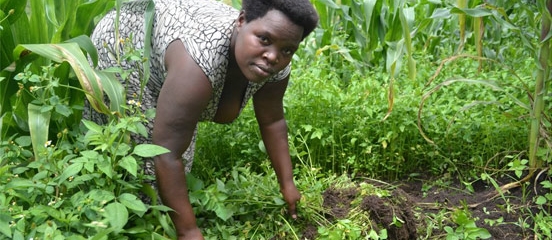Postcard from Uganda - Amazing maize
14 November 2012

You might expect to see red earth here in the foothills of the Mountains of the Moon, a stone’s throw from the Congo border. But here in western Uganda the soil is black, rich as truffle, and so densely nutritious that it could be sold as compost. Or as chocolate cake, come to that.
“We don’t need any fertilizers here,” smiles a corn farmer, crumbling the black earth through her fingers, “this is the richest volcanic soil you will ever see.”
I don’t doubt it. Yet despite the mineral-rich earth, many crops in this district of Kabarole have failed. Disease and poor quality seeds leave farmers with meager harvests, in a place where around 70,000 households exist by smallholder farming.
How to grow corn
I’m here visiting a Farm Africa project that is boosting local agriculture so that corn yields match the quality of the earth producing them and the effort put in by the farmers. These farmers sow their seeds in the traditional way, which generates sparse harvests. And because they live from one harvest to the next, they have to sell their surplus corn immediately rather than storing it until prices rise or working it into more profitable products like flour, bran or bread.
But that’s all changing. This three-year Farm Africa project will reach about 2,000 families by supporting 60 farmers’ groups. It targets women farmers, with the goal of producing four times as much yield. And with drying racks and mobile threshing machines, it is helping them to prepare to make their crop cleaner and longer-lasting so it brings in more money after harvest.
Reap what you sow
You can only reap what you sow. That’s why Farm Africa began by introducing a variety of corn better suited to local conditions, and trained the farmers to sow the seed in rows to enable easier weeding and a better-nourished and better-ventilated crop. The new variety gives two harvests a year, raising an average farmer’s yield from 2,200lb to 8,800lb a year.
Another truism is waste not, want not. Women farmers make charcoal-substitute briquettes for cooking fires, in a brilliant ‘nose to tail’ use for corn. This process was enthusiastically demonstrated for me, against the background of the rainforest it preserves. The women first burned the stripped husks and papery cob sheaths in an oil drum, and then mixed the resulting ash with cornflour and water. This black paste was cranked through a machine, until sausage-shaped pellets squidged out. Dried, the pellets can be used and sold as cooking fuel, reducing the number of trees felled for fuel and making sure none of the crop is wasted after harvest.
Read more about our corn project
By Jane Spence
